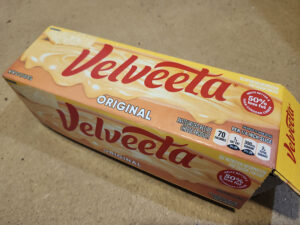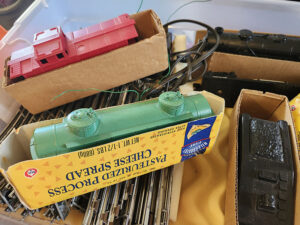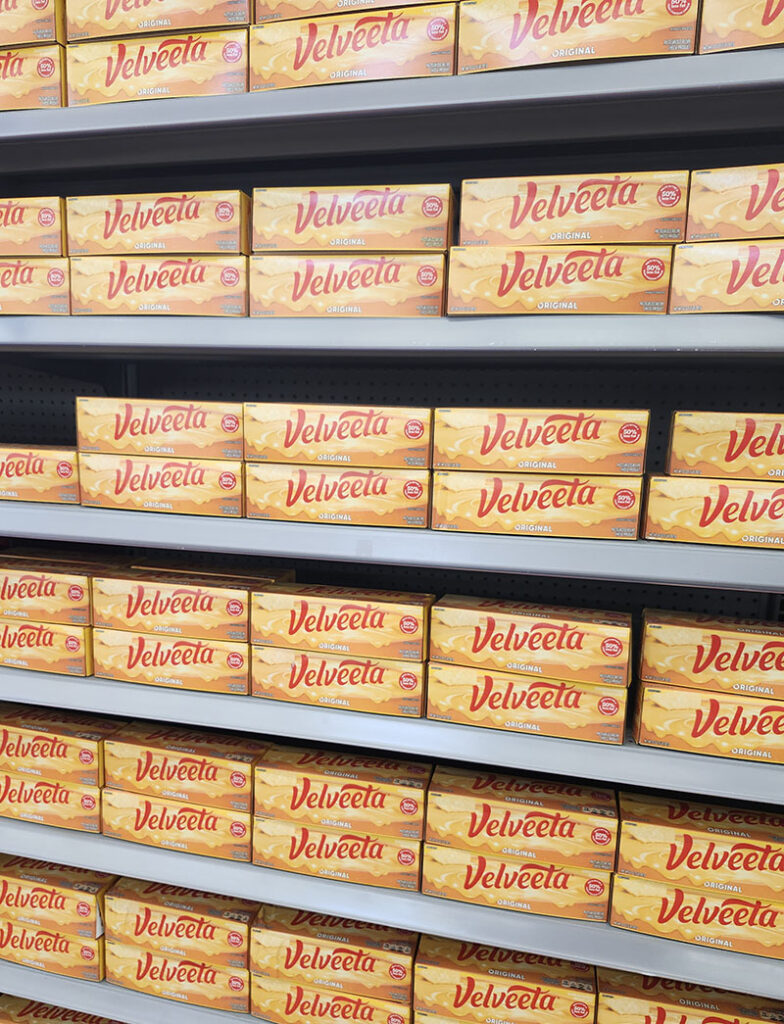 July 23, 2025–I am experiencing a food deja vue. I have rediscovered the magic that is Velveeta.
July 23, 2025–I am experiencing a food deja vue. I have rediscovered the magic that is Velveeta.
We all remember the velvety golden smoothness of American pasteurized process cheese product from our childhoods. Its ooey goodness made everything taste better–macaroni (we called all pasta macaroni), hamburgers, ballpark nachos, bologna sandwiches, and nameless casseroles moms churned out from church supper leftovers. I practically raised my kids on mac and cheese, rationalizing that at least the Velveeta version wasn’t that powdery yellow stuff that came in cardboard boxes with cardboard pasta.
Speaking of packaging, KRAFT mastered marketing this stuff.
Picking up a hefty one-pound loaf of cheese felt like you were getting real value for money. First of all, calling it a “loaf” put it into the baked goods category. Then there was the remarkable design. In the store you couldn’t miss the bright yellow cover, perched on the shelf like a gold ingot. Inside lay the cheese, wrapped in silvery foil and snuggled inside a sturdy corrugated cardboard box. (As a boy, I discovered those boxes were the perfect size to hold one of my Lionel train cars. To this day, those trains are stored in cheese boxes from my childhood.)
You would dump out the sleeved loaf onto a cutting board and slit the foil back, revealing a perfectly-formed rectangular extrusion of a substance that was not quite cheese and not quite Play-Doh, but when melted, made your meat, starch, or vegetable even more delicious. And nothing else–nothing–elevates a can of RoTel to chip-dipping nirvana as Velveeta brand pasteurized process cheese.
Then the health harpies unfurled their flags. Processed cheese is not real cheese, they preached. You are eating plastic and artificial flavors and colors. No, they railed, it is best to eat real cheeses, such as Bleu Cheese (which is laced with mold), Limburger (which smells like a teenage boy’s gym locker), and Gruyere (which is filled with holes). You should eat cheese from Ireland, they said, made with milk from fen-fed cows, or feta, made from the milk of nervous ewes.
For me, Velveeta was the gateway food that helped me acquire a taste for those haute fromages. But they all lacked the one characteristic that made Velveeta magic: they didn’t melt. Stirring a sharp cheddar into a pan of hot pasta turns it into an unappealing lumpy mass. Frying Swiss between slices of bread makes it bubble and burn. Topping nacho chips with Pepper Jack creates a stringy, uneven mess.
Then, vindication. I stumbled across a cooking podcast host who swore that Velveeta is the only cheese worthy of being part of a cheeseburger. His passion caused me to become curious, so I rekindled my interest in the cheese of childhood.
To my surprise, I discovered this truth about American processed cheese: it’s made of real cheese, but can’t be labeled “cheese” because the quantity is less than 50%. The rest is milk and whey. It is high in salt and has coloring, but no one I know is living on the stuff. An occasional slice on a burger is not going to coagulate your arteries.
 Further, I just learned that 95% of cheeses made in the U.S. now use artificial rennet, that disgusting set of enzymes produced in the stomachs of ruminants that transmogrifies milk into cheese. Take that, you fickle fonduers.
Further, I just learned that 95% of cheeses made in the U.S. now use artificial rennet, that disgusting set of enzymes produced in the stomachs of ruminants that transmogrifies milk into cheese. Take that, you fickle fonduers.
So I wave my pasteurized process cheese product flag proudly as I rediscover the gooey goodness of good old American cheese. It needs to be reinstated on the buffet boards of American diets, layered upon burgers, topping casseroles, ladled on nachos, and bubbling over Sterno cans, claiming its rightful place as one of America’s greatest culinary innovations.
Admit it–you want some.